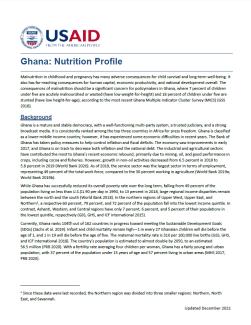Ghana is a mature and stable democracy, with a well-functioning multi-party system, a trusted judiciary, and a strong broadcast media. It is consistently ranked among the top three countries in Africa for press freedom. Ghana is classified as a lower-middle income country; however, it has experienced some economic difficulties in recent years. The Bank of Ghana has taken policy measures to help control inflation and fiscal deficits. The economy saw improvements in early 2017, and Ghana is on track to decrease both inflation and the national debt. The industrial and agricultural sectors have contributed the most to Ghana’s recent economic rebound, primarily due to mining, oil, and good performance in crops, including cocoa and fisheries. However, growth in non-oil activities decreased from 6.5 percent in 2018 to 5.8 percent in 2019 (World Bank 2020). As of 2019, the service sector was the largest sector in terms of employment, representing 49 percent of the total work force, compared to the 30 percent working in agriculture (World Bank 2019a; World Bank 2019b).
While Ghana has successfully reduced its overall poverty rate over the long term, falling from 49 percent of the population living on less than U.S.$1.90 per day in 1990, to 13 percent in 2018, large regional income disparities remain between the north and the south (World Bank 2018). In the northern regions of Upper West, Upper East, and Northern1, a respective 60 percent, 79 percent, and 72 percent of the population fall into the lowest income quintile. In contrast, Ashanti, Western, and Central regions have only 7 percent, 6 percent, and 5 percent of their populations in the lowest quintile, respectively (GSS, GHS, and ICF International 2015).
Currently, Ghana ranks 104th out of 162 countries in progress toward meeting the Sustainable Development Goals (SDGs) (Sachs et al. 2019). Infant and child mortality remain high—1 in every 27 Ghanaian children will die before the age of 1, and 1 in 19 will die before the age of five. The maternal mortality rate is 310 per 100,000 live births (GSS, GHS, and ICF International 2018). The country’s population is estimated to almost double by 2050, to an estimated 56.5 million (PRB 2020). With a fertility rate averaging four children per woman, Ghana has a fairly young and urban population, with 37 percent of the population under 15 years of age and 57 percent living in urban areas (MHS 2017; PRB 2020).

